S.S. Lazio
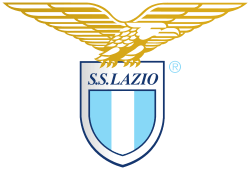 | ||||
| Full name | Società Sportiva Lazio S.p.A. | |||
|---|---|---|---|---|
| Nickname(s) |
I Biancocelesti (The White and Sky Blues) Le Aquile (The Eagles) | |||
| Founded | 9 January 1900, as Società Podistica Lazio | |||
| Ground | Stadio Olimpico | |||
| Capacity | 70,634[1] | |||
| Owner | Claudio Lotito (66.692%)[2] | |||
| Chairman | Claudio Lotito | |||
| Manager | Simone Inzaghi | |||
| League | Serie A | |||
| 2017–18 | Serie A, 5th | |||
| Website | Club website | |||
|
| ||||

Società Sportiva Lazio S.p.A., (BIT: SSL) commonly referred to as Lazio (Italian pronunciation: [ˈlatsjo]), is a professional Italian sports club based in Rome, most known for its football activity.[3] The society, founded in 1900, plays in the Serie A and have spent most of their history in the top tier of Italian football. Lazio have been Italian champions twice (1974, 2000), and have won the Coppa Italia six times, the Supercoppa Italiana four times, and both the UEFA Cup Winners' Cup and UEFA Super Cup on one occasion.[4]
The club had their first major success in 1958, winning the domestic cup. In 1974, they won their first Serie A title. The 1990s have been the most successful period in Lazio's history, seeing them win the UEFA Cup Winners' Cup and UEFA Super Cup in 1999, the Serie A title in 2000, and reaching their first UEFA Cup final in 1998.
Lazio's traditional kit colours are sky blue shirts and white shorts with white socks; the colours are reminiscent of Rome's ancient Hellenic legacy. Sky blue socks have also been interchangeably used as home colours. Their home is the 70,634[1] capacity Stadio Olimpico in Rome, which they share with A.S. Roma until 2020, when the latter will leave for the Stadio della Roma. Lazio have a long-standing rivalry with Roma, with whom they have contested the Derby della Capitale (in English "Derby of the capital city" or Rome derby) since 1929.[5]
Despite initially not having any parent–subsidiary relation with the male and female professional team (that was incorporated as S.S. Lazio S.p.A.), the founding of Società Sportiva Lazio allowed for the club that participates in over 40 sports disciplines in total, more than any other sports association in the world.[6][7]
History
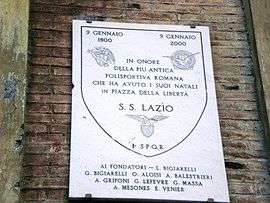
Società Podistica Lazio was founded on 9 January 1900 in the Prati district of Rome.[8] Until 1910, the club played at an amateur level until it officially joined the league competition in 1912 as soon as the Italian Football Federation began organising championships in the center and south of Italy, and reached the final of the national championship playoff three times, but never won, losing in 1913 to Pro Vercelli, in 1914 to Casale and in 1923 to Genoa 1893.
In 1927, Lazio was the only major Roman club which resisted the Fascist regime's attempts to merge all the city's teams into what would become A.S. Roma the same year.
The club played in the first organised Serie A in 1929 and, led by legendary Italian striker Silvio Piola,[9] achieved a second-place finish in 1937 – its highest pre-war result.
The 1950s produced a mix of mid and upper table results with a Coppa Italia win in 1958. Lazio was relegated for the first time in 1961 to the Serie B, but returned in the top flight two years later. After a number of mid-table placements, another relegation followed in 1970–71.[10] Back to Serie A in 1972–73, Lazio immediately emerged as surprise challengers for the Scudetto to Milan and Juventus in 1972–73, only losing out on the final day of the season, with a team comprising captain Giuseppe Wilson, as well as midfielders Luciano Re Cecconi and Mario Frustalupi, striker Giorgio Chinaglia, and head coach Tommaso Maestrelli.[11] Lazio improved such successes the following season, ensuring its first title in 1973–74.[12][13] However, tragic deaths of Re Cecconi[14] and Scudetto trainer Maestrelli, as well as the departure of Chinaglia, would be a triple blow for Lazio. The emergence of Bruno Giordano during this period provided some relief as he finished League top scorer in 1979, when Lazio finished eighth.[15]

Lazio were forcibly relegated to Serie B in 1980 due to a remarkable scandal concerning illegal bets on their own matches, along with Milan. They remained in Italy's second division for three seasons in what would mark the darkest period in Lazio's history. They would return in 1983 and manage a last-day escape from relegation the following season. The 1984–85 season would prove harrowing, with a pitiful 15 points and bottom place finish.
In 1986, Lazio was hit with a nine-point deduction (a true deathblow back in the day of the two-point win) for a betting scandal involving player Claudio Vinazzani. An epic struggle against relegation followed the same season in Serie B, with the club led by trainer Eugenio Fascetti only avoiding relegation to the Serie C after play-off wins over Taranto and Campobasso. This would prove a turning point in the club's history, with Lazio returning to Serie A in 1988 and, under the careful financial management of Gianmarco Calleri, the consolidation of the club's position as a solid top-flight club.[16][17]
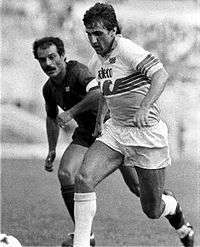
The arrival of Sergio Cragnotti in 1992 changed the club's history due to his long-term investments in new players to make the team a Scudetto competitor. A notable early transfer during his tenure was the capture of English midfielder Paul Gascoigne from Tottenham Hotspur for £5.5 million. Gascoigne's transfer to Lazio is credited with the increase of interest in Serie A in the United Kingdom during the 1990s. Cragnotti repeatedly broke transfer records in pursuit of players who were considered major stars – Juan Sebastián Verón for £18 million, Christian Vieri for £19 million and breaking the world transfer record, albeit only for a matter of weeks, to sign Hernán Crespo from Parma for £35 million.[18]
Lazio were Serie A runners-up in 1995, third in 1996 and fourth in 1997, then losing the championship just by one point to Milan on the last championship's match in 1999 before, with the likes of Siniša Mihajlović, Alessandro Nesta, Marcelo Salas and Pavel Nedvěd in the side, winning its second Scudetto in 2000, as well as the Coppa Italia double with Sven-Göran Eriksson (1997–2001) as manager.

Lazio had two more Coppa Italia triumphs in 1998 and 2004, as well as the last ever UEFA Cup Winners' Cup in 1999.[19] They also reached the UEFA Cup, but lost 0–3 against Internazionale.[20]
In addition, Lazio won the Supercoppa Italiana twice and defeated Manchester United in 1999 to win the UEFA Super Cup.[21]
In 2000, Lazio became also the first Italian football club to be quoted on the Italian Piazza Affari stock market.[22]
With money running out, however, Lazio's results slowly worsened in the years. In 2002, a financial scandal involving Cragnotti and his food products multinational Cirio forced him to leave the club, and Lazio was controlled until 2004 by caretaker financial managers and a bank pool. This forced the club to sell their star players and even fan favourite captain Alessandro Nesta. In 2004, entrepreneur Claudio Lotito acquired the majority of the club.[23]
In 2006, the club qualified to the 2006–07 UEFA Cup under coach Delio Rossi. The club, however, was excluded from European competitions due to their involvement in a match-fixing scandal.[24]
In the 2006–07 season, despite a later-reduced points deduction, Lazio achieved a third-place finish, thus gaining qualification to the UEFA Champions League third qualifying round, where they defeated Dinamo București to reach the group phase, and ended fourth place in the group composed of Real Madrid, Werder Bremen and Olympiacos. Things in the league did not go much better, with the team spending most of the season in the bottom half of the table, sparking the protests of the fans, and eventually ending the Serie A season in 12th place. In the 2008–09 season, Lazio won their fifth Coppa Italia, beating Sampdoria in the final.[25]
Lazio started the 2009–10 season playing the Supercoppa Italiana against Inter in Beijing and winning the match 2–1, with goals from Matuzalém and Tommaso Rocchi.[26]
Lazio won the 2012–13 Coppa Italia 1–0 over rivals Roma with the lone goal coming from Senad Lulić.[27]
Colours, badge and nicknames
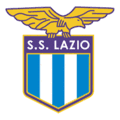
Lazio's colours of white and sky blue were inspired by the national emblem of Greece, due to the fact that Lazio is a mixed sports club this was chosen in recognition of the fact that the Ancient Olympic Games and along with it the sporting tradition in Europe is linked to Greece.[28]
Originally, Lazio wore a shirt which was divided into white and sky blue quarters, with black shorts and socks.[29] After a while of wearing a plain white shirt very early on, Lazio reverted to the colours which they wear today.[29] Some seasons Lazio have used a sky blue and white shirt with stripes, but usually it is sky blue with a white trim, with the white shorts and socks.[29] The club's colours have led to their Italian nickname of Biancocelesti.[30]
Lazio's traditional club badge and symbol is the eagle, which was chosen by founding member Luigi Bigiarelli.[31] It is an acknowledgment to the emblem of Zeus (the god of sky and thunder in Greek mythology) commonly known as the Aquila; Lazio's use of the symbol has led to two of their nicknames; le Aquile ("the Eagles") and Aquilotti ("Eaglets"). The current club badge features a golden eagle above a white shield with a blue border; inside the shield is the club's name and a smaller tripartite shield with the colours of the club.
Stadium
Stadio Olimpico, located on the Foro Italico, is the major stadium of Rome. It is the home of the Italy national football team as well as of both local teams Lazio and Roma. It was opened in 1937 and after its latest renovation in 2008,[32] the stadium has a capacity of 70,634 seats.[1] It was the site of the 1960 Summer Olympics, but has also served as the location of the 1987 World Athletics Championships, the 1980 European Championship final, the 1990 World Cup and the Champions League Final in 1996 and 2009.[1]
Also on the Foro Italico lies the Stadio dei Marmi, or "marble stadium", which was built in 1932 and designed by Enrico Del Debbio. It has tiers topped by 60 white marble statues that were gifts from Italian cities in commemoration of 60 athletes.
During the 1989–90 season, Lazio and Roma played their games at the Stadio Flaminio of Rome, located in the district Flaminio, because of the renovation works carried out at the Stadio Olimpico.
Supporters and rivalries
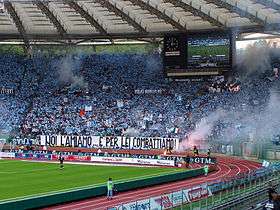
Lazio is the sixth-most supported football club in Italy and the second in Rome, with around 2% of Italian football fans supporting the club (according to La Repubblica's research of August 2008).[33] Historically, the largest section of Lazio supporters in the city of Rome has come from the far northern section, creating an arch-like shape across Rome with affluent areas such as Parioli, Prati, Flaminio, Cassia and Monte Mario.[34]
Founded in 1987, Irriducibili Lazio were the club's biggest ultras group for over 20 years. They typically create traditional Italian ultra displays during the Derby della Capitale (Rome Derby),[35] the match between Lazio and their main rivals, Roma. It is amongst the most heated and emotional footballing rivalries in the world,[36] such as where Lazio fan Vincenzo Paparelli was killed at one of the derby games during the 1979–80 season after being hit in the eye by an emergency rocket thrown by a Roma fan.[37] A minority of Lazio's ultras used to use swastikas and fascist symbols on their banners, and they have displayed racist behaviour in several occasions during the derbies. Most notably, at a derby of the season 1998–99, laziali unfurled a 50-metre banner around the Curva Nord that read, "Auschwitz is your town, the ovens are your houses". Black players of Roma have often been receivers of racist and offensive behaviour.[38] Lazio also have a strong rivalry with Napoli and Livorno, as well as with Pescara and Atalanta. The club also maintains strong competitive rivalries with Fiorentina, Juventus, and Milan.
Conversely, the ultras have friendly relationships with Internazionale, Triestina, and Hellas Verona. Internationally, Lazio's fans maintain a long-standing strong friendship with the supporters of the Bulgarian club Levski Sofia and as such, Lazio were invited to participate in the centenary football match honouring the birthday of the Bulgarian club.[39][40]
Players
Current squad
- As of 2 September 2018[41]
Note: Flags indicate national team as defined under FIFA eligibility rules. Players may hold more than one non-FIFA nationality.
|
|
Other players under contract
Note: Flags indicate national team as defined under FIFA eligibility rules. Players may hold more than one non-FIFA nationality.
|
|
Out on loan
- As of 2 September 2018
Note: Flags indicate national team as defined under FIFA eligibility rules. Players may hold more than one non-FIFA nationality.
|
|
Youth Sector
Retired numbers
12 – Since the 2003–04 season, Curva Nord of Stadio Olimpico, as a sign of recognition towards the Curva Nord, is considered the 12th man in the field.
Notable managers
The following managers have all won at least one trophy when in charge of Lazio:
| Name | Period | Trophies |
|---|---|---|
| Fulvio Bernardini | 1958–1960 | Coppa Italia |
| Juan Carlos Lorenzo | 1968–1971 | Serie B |
| Tommaso Maestrelli | 1971–1975 | Serie A |
| Sven-Göran Eriksson | 1997–2001 | 2 Coppa Italia, 2 Supercoppa Italiana, Serie A, UEFA Cup Winners' Cup, UEFA Super Cup |
| Roberto Mancini | 2002–2004 | Coppa Italia |
| Delio Rossi | 2005–2009 | Coppa Italia |
| Davide Ballardini | 2009–2010 | Supercoppa Italiana |
| Vladimir Petković | 2012–2013 | Coppa Italia |
| Simone Inzaghi | 2016–present | Supercoppa Italiana |
Honours
National
- Winners (1): 1968–69
European
- Winners (1): 1998–99
- Winners (1): 1999
Statistics and records
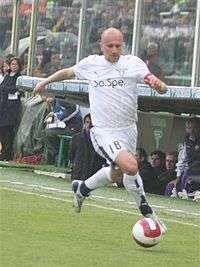
.jpg)
Giuseppe Favalli holds Lazio's official appearance record, having made 401 over the course of 16 years from 1992 until 2004.[50] The record for total appearances by a goalkeeper is held by Luca Marchegiani, with 339 appearances,[50] while the record for most league appearances is held by Aldo Puccinelli with 339.[50]
The all-time leading goalscorer for Lazio is Silvio Piola, with 149 goals scored.[50] Piola, who played also with Pro Vercelli, Torino, Juventus and Novara, is also the highest goalscorer in Serie A history, with 274 goals.[51] Simone Inzaghi is the all-time top goalscorer in the European Competitions, with 20 goals.[50] He is also one of the five players who scored four goals in a single UEFA Champions League match.[52]
Officially, Lazio's highest home attendance is approximately 80,000 for a Serie A match against Foggia on 12 May 1974, the match that awarded to Lazio their first Scudetto. This is also the record for the Stadio Olimpico, including matches held by Roma and the Italy national football team.[6]
Società Sportiva Lazio as a company
In 1998, during Sergio Cragnotti's period in charge as the chairman, Società Sportiva Lazio S.p.A. became a listed company: Lazio were the first Italian club to do so.[53][54] However, Cragnotti resigned as chairman in 2001, after a "huge hole in the budget" of the club.[55]
Claudio Lotito, the current chairman of Lazio, purchased the club from Cragnotti in 2004, but owned just 26.969% of shares as the largest shareholders at that time. It was followed by banking group Capitalia (and its subsidiaries Mediocredito Centrale, Banca di Roma and Banco di Sicilia) as the second largest shareholders for 17.717%.[56] Capitalia also hold 49% stake of Italpetroli (via Capitalia's subsidiary Banca di Roma), the parent company of city rival Roma (via Italpetroli's subsidiary "Roma 2000").[57] Lotito later purchased the minority stake from Capitalia.
As of 2018, Claudio Lotito owns just over two-thirds of the shares of Lazio.[58] Lazio is one of only three Italian clubs listed on the Borsa Italiana, the others being Juventus and Roma.[54][59] In the past, Lazio was the only one with a single primary share holder (Lotito). However, following several capital increases by Roma and Juventus, they also are significantly owned by a shareholder. According to The Football Money League, published by consultants Deloitte, in the 2004–05 season, Lazio was the 20th highest earning football club in the world with an estimated revenue of €83 million;[60] the 2005 ranking of the club was 15th.[60] However, in 2016 ranking (the rank used data in 2014–15 season), Lazio was not in the top 20.[61]
Lazio was one of the few clubs that self-sustain from the financial support of a shareholder, and also consistently make an aggregate profit after every season. Unlike Inter Milan, Roma and Milan, who were sanctioned by UEFA due to breaches of Financial Fair Play, Lazio passed the regulations held by the administrative body with the high achievements. Lotito also received a prize that joint awarded by Associazione Italiana Allenatori Calcio and DGS Sport&Cultura, due to Lazio's financial health.[62]
In 2017, the club renewed their sponsorship deal with shirt manufacturer Macron. It is worth €16 million a season, plus variables of about €9 million stemming from league and European competition finishes.[63]
| Year | Turnover | Result | Total Assets | Net Assets |
|---|---|---|---|---|
| 2005–06 | €87,945,533 | €16,790,826 | €150,061,486 | (€25,406,939) |
| 2006–07 | ||||
| 2007–08 | ||||
| 2008–09 | ||||
| 2009–10 | ||||
| 2010–11 | ||||
| 2011–12 | ||||
| 2012–13 | ||||
| 2013–14 | ||||
| 2014–15 | ||||
| 2015–16 | ||||
| 2016–17 |
Sponsors and kit providers
| Years | Kit providers | Shirt sponsor |
|---|---|---|
| 1946–1961 | Gradella Sport | No sponsor |
| 1961–1962 | Lacoste | |
| 1962–1963 | Gradella Sport | |
| 1963–1964 | Lacoste | |
| 1964–1969 | Gradella Sport | |
| 1969–1970 | Maglificio Lama Tuttosport Umbro | |
| 1970–1971 | Umbro | |
| 1971–1975 | Tuttosport | |
| 1975–1979 | NR (Ennerre) | |
| 1979–1980 | NR (Ennerre) Pouchain | |
| 1980–1981 | Adidas | |
| 1981–1982 | Tonini | |
| 1982–1984 | NR (Ennerre) | Seleco |
| 1984–1986 | Castor | |
| 1986–1987 | Tuttosport | Cassa di Risparmio di Roma |
| 1987–1989 | Kappa | |
| 1989–1991 | Umbro | |
| 1991–1992 | Banco di Santo Spirito | |
| 1992–1996 | Banca di Roma | |
| 1996–1998 | Cirio | |
| 1998–2000 | Puma | |
| 2000–2003 | Siemens Mobile | |
| 2003–2005 | Parmacotto | |
| 2005–2007 | INA Assitalia | |
| 2007–2008 | So.Spe. Edileuropa | |
| 2008–2009 | No sponsor | |
| 2009–2010 | Edileuropa | |
| 2010–2012 | No sponsor | |
| 2012–2017 | Macron | |
| 2017–2018 | Seleco | |
| 2018– | Marathonbet |
See also
References
- 1 2 3 4 "Stadi Serie A 2015–2016" (PDF). Archived from the original (PDF) on 1 September 2015.
- ↑ "Azionisti rilevanti di SOCIETA' SPORTIVA LAZIO SPA" [List of major shareholders of S.S. Lazio]. CONSOB. 22 March 2018.
- ↑ "Storia". S.S. Lazio (in Italian). Retrieved 9 January 2011.
- ↑ "Palmares". S.S. Lazio (in Italian). Retrieved 9 January 2011.
- ↑ "Il Derby della Capitale". CBC. 28 November 2007. Retrieved 4 November 2009.
- 1 2 "La Storia". S.S. Lazio S.p.A. (in Italian). Archived from the original on 30 August 2010. Retrieved 9 January 2011.
- ↑ http://www.sslazio.org
- ↑ "Club info". S.S. Lazio. Retrieved 9 January 2011.
- ↑ "Silvio Piola". cronologia.leonardo.it. Retrieved 7 June 2008.
- ↑ "Italy 1970/71". RSSSF. Retrieved 15 June 2008.
- ↑ "La Lazio di Re Cecconi". vecchiasignora.com. Retrieved 15 June 2008.
- ↑ "I banditi e i Campioni – Lazio '73–'74 – Uno scudetto "contro" tutto e tutti". postadelgufo.it. Archived from the original on 13 February 2009. Retrieved 15 June 2008.
- ↑ "Italy 1973/74". RSSSF. Retrieved 15 June 2008.
- ↑ Paolo Benetollo. "Luciano Re Cecconi, l'Angelo biondo". pagine70.com. Retrieved 15 June 2008.
- ↑ "Italy 1978/79". RSSSF. Retrieved 15 June 2008.
- ↑ "Italy 1988/89". RSSSF. Retrieved 14 October 2008.
- ↑ "Italy 1989/90". RSSSF. Retrieved 14 October 2008.
- ↑ "Lazio's £40m Crespo deal". BBC Sport. 12 July 2000. Retrieved 4 November 2009.
- ↑ "Lazio leave it late". UEFA. 19 May 1999. Archived from the original on 24 October 2010. Retrieved 9 January 2011.
- ↑ "Zamorano leads Inter rout". UEFA. 1 June 1998. Archived from the original on 25 June 2010. Retrieved 9 January 2011.
- ↑ "Salas downs United". UEFA. 1 September 1999. Archived from the original on 31 August 2010. Retrieved 27 October 2009.
- ↑ Capone, Antonello (3 February 2000). "Da oggi la Roma è quotata in Borsa". La Gazzetta dello Sport. Retrieved 14 October 2008.
- ↑ "Claudio Lotito is the new Lazio chairman". guide.dada.net. Archived from the original on 7 October 2008. Retrieved 12 June 2008.
- ↑ "Prima sentenza sullo scandalo calcio: Juve, Lazio e Fiorentina in serie B". La Repubblica. Retrieved 12 June 2008.
- ↑ "Lazio win the Coppa Italia". ESPN Star Sports. 14 May 2009. Archived from the original on 24 March 2012. Retrieved 9 January 2011.
- ↑ "Supercoppa alla Lazio. Battuta l'Inter 2–1". La Gazzetta dello Sport (in Italian). 8 August 2009. Retrieved 11 August 2009.
- ↑ "Roma-Lazio 0-1, decide un gol di Lulic. Biancocelesti in Europa" (in Italian). La Gazzetta della Sport. 26 May 2013. Retrieved 2 February 2017.
- ↑ "Lazio". albionroad.com. 24 June 2007. Archived from the original on 24 February 2016.
- 1 2 3 "Maglie". ultraslazio.it. 24 June 2007. Archived from the original on 14 July 2013.
- ↑ "Lazio Football Team Information". football.co.uk. 24 June 2007.
- ↑ "Evoluzione di un simbolo nobile e glorioso". ultraslazio.it. 24 June 2007. Archived from the original on 23 February 2012.
- ↑ "Stadio Olimpico – nuove tecniche di safety & security". Vigili del Fuoco (in Italian). Archived from the original on 22 July 2011. Retrieved 14 October 2009.
- ↑ Bordignon, Fabio; Ceccarini, Luigi (8 August 2008). "Tifosi, Juventus la più amata. Inter la più antipatica". La Repubblica (in Italian). Retrieved 15 October 2009.
- ↑ "S.S. Lazio". ITV-Football. 29 June 2007. Archived from the original on 20 February 2008.
- ↑ "Italian Ultras Scene". View from the Terrace. 29 June 2007. Archived from the original on 8 May 2009.
- ↑ Duke, Greg (22 October 2008). "Football First 11: Do or die derbies". CNN. Retrieved 4 November 2009.
- ↑ "Ultras History". ultraslazio.it. 29 June 2007. Archived from the original on 16 June 2013.
- ↑ "Play stopped after Lazio supporters racially abuse Napoli's Kalidou Koulibaly". thescore.com.
- ↑ "Levski Sofia – Lazio centenario". Youtube. 23 May 2014. Retrieved 1 August 2016.
- ↑ "Levski Sofia-Lazio 3-2, amichevole centenario". sportpeople.net. 24 May 2014. Retrieved 1 August 2016.
- ↑ "Squad - Lazio ǀ Lega Serie A" (in Italian). Retrieved 19 August 2018.
- ↑ "Δανεισμός Ιβάν Βάργκιτς". 31 August 2018. Retrieved 2 September 2018.
- 1 2 3 "Comunicato 17.08.2018". 17 August 2018. Retrieved 2 September 2018.
- ↑ "Comunicato 17.08.2018". 17 August 2018. Retrieved 2 September 2018.
- ↑ "Comunicato 30.08.2018" (in Italian). S.S. Lazio. 30 August 2018.
- ↑ "Official: Parma sign Sprocati". Football Italia. 17 August 2018.
- ↑ "UFFICIALE: Lazio, Kishna all'ADO Den Haag. Javorcic all'Amiens". Retrieved 1 September 2018.
- ↑ "Palombi on loan to Lecce". Retrieved 19 July 2018.
- ↑ "Official: Lazio loan out Tounkara". Football Italia. 3 July 2018.
- 1 2 3 4 5 "Record". S.S. Lazio. Retrieved 9 January 2011.
- ↑ "Italy – All-Time Topscorers". RSSSF. Retrieved 12 October 2009.
- ↑ Sannucci, Corrado (15 March 2000). "Inzaghi show, la Lazio è tornata". La Repubblica (in Italian). p. 55. Retrieved 30 October 2009.
- ↑ "S.S. Lazio S.p.A". Funding Universe. 29 June 2007.
- 1 2 "La Lazio debutta in Borsa il giorno della coppa Uefa". La Repubblica (in Italian). 21 April 1998. p. 9. Retrieved 27 October 2009.
- ↑ Caioli, Luca (2012). Roberto Mancini: A Footballing Life: The Full Story. Icon Books. Retrieved 8 April 2018.
- ↑ "Azionisti rilevanti di SOCIETA' SPORTIVA LAZIO SPA". CONSOB. 31 December 2004. Archived from the original on 13 March 2016. Retrieved 12 March 2016.
- ↑ "2004 Bilancio" (PDF). Capitalia (in Italian). Borsa Italiana archive. 28 February 2005. Retrieved 12 March 2016.
- ↑ "S.S. Lazio SpA". consob.it. 8 June 2007. Archived from the original on 29 January 2016.
- ↑ "Lazio". Borsa Italiana (in Italian). Retrieved 27 October 2009.
- 1 2 "Football Money League" (PDF). Deloitte. February 2006. Retrieved 16 May 2018.
- ↑ "Top of the table Football Money League" (PDF). Deloitte. January 2016. Retrieved 16 May 2018.
- ↑ "PREMIO 'FINANCIAL FAIR PLAY' ALLA LAZIO DI LOTITO" (in Italian). S.S. Lazio. 16 April 2015. Retrieved 16 January 2016.
- ↑ "Coumincato Stampa: Accordo Macron Lazio Marketing" [Press Release: Agreement Macron Lazio Marketing] (PDF) (in Italian). S.S. Lazio. 8 February 2017. Retrieved 7 March 2017.
- ↑ "S.S. Lazio 2006–07 annual report" (PDF). S.S. Lazio (in Italian). 18 October 2007. Archived from the original (PDF) on 24 September 2015. Retrieved 7 August 2011.
- ↑ "S.S. Lazio 2007–08 annual report" (PDF). S.S. Lazio (in Italian). 23 October 2008. Archived from the original (PDF) on 24 September 2015. Retrieved 7 August 2011.
- ↑ "S.S. Lazio 2008–09 annual report" (PDF). S.S. Lazio (in Italian). 27 October 2009. Archived from the original (PDF) on 24 September 2015. Retrieved 7 August 2011.
- ↑ "S.S. Lazio 2009–10 annual report" (PDF). S.S. Lazio (in Italian). 28 October 2010. Retrieved 7 August 2011.
- ↑ "S.S. Lazio 2010–11 annual report" (PDF). S.S. Lazio (in Italian). 6 October 2011. Archived from the original (PDF) on 24 September 2015. Retrieved 18 October 2011.
- ↑ "S.S. Lazio 2011–12 annual report" (PDF). S.S. Lazio (in Italian). 4 October 2012. Archived from the original (PDF) on 24 September 2015. Retrieved 4 February 2013.
- ↑ "Bilancio S.S. Lazio al 30 giugno 2013" (PDF) (in Italian). S.S. Lazio. 8 October 2013. Retrieved 6 January 2016.
- ↑ "Bilancio S.S. LAZIO al 30 giugno 2014" (PDF) (in Italian). S.S. Lazio. 7 October 2014. Retrieved 6 January 2016.
- ↑ "Bilancio S.S. LAZIO al 30 giugno 2015" (PDF) (in Italian). S.S. Lazio. 7 October 2015. Retrieved 6 January 2016.
- ↑ "Comunicato_Stampa: approvato il progetto di Bilancio 30-06-16" (PDF) (in Italian). S.S. Lazio. 22 September 2016. Retrieved 7 October 2016.
- ↑ "Bilancio S.S. LAZIO SpA 30-06-17 appr. 06-10-2017" (PDF) (in Italian). S.S. Lazio. 6 October 2017. Retrieved 28 March 2018.
Sources
- Melli, Franco and Marco (2005). La storia della Lazio (in Italian). Rome: L'airone Editrice. ISBN 88-7944-725-4.
- Barbero, Sergio (1999). Lazio. Il lungo volo dell'aquila (in Italian). Graphot. ISBN 88-86906-19-6.
- Barraco, Egidio (1992). Nella Lazio ho giocato anch'io. Novantanni in biancoazzurro (in Italian). Aldo Pimerano. ISBN 88-85946-09-7.
- Bocchio, Sandro; Giovanni Tosco (2000). Dizionario della grande Lazio (in Italian). Newton & Compton. ISBN 88-8289-495-9.
- Cacciari, Patrizio; Filacchione; Stabile (2004). 1974. Nei ricordi dei protagonisti la storia incredibile della Lazio di Maestrelli (in Italian). Eraclea Libreria Sportiva. ISBN 88-88771-10-7.
- Chinaglia, Giorgio (1984). Passione Lazio (in Italian). Rome: Lucarini. ISBN 88-7033-051-6.
- Chiappaventi, Guy (2004). Pistole e palloni. Gli anni Settanta nel racconto della Lazio campione d'Italia (in Italian). Limina. ISBN 88-88551-30-1.
- Filacchione, Marco. Il volo dell'aquila. Numeri e uomini della grande Lazio (in Italian). Eraclea Libreria Sportiva. ISBN 88-88771-08-5.
- Martin, Simon (2006). Calcio e fascismo. Lo sport nazionale sotto Mussolini (in Italian). Mondadori. ISBN 88-04-55566-1.
- Melli, Franco (2000). Cara Lazio (in Italian). Rome: Lucarini. ISBN 88-7033-297-7.
- Melli, Franco (2000). Saga biancazzurra. La Lazio, Cragnotti, il nuovo potere (in Italian). Rome: Limina. ISBN 88-86713-56-8.
- Pennacchia, Mario (1994). Lazio patria nostra: storia della società biancoceleste (in Italian). Rome: Abete Edizioni. ISBN 88-7047-058-X.
- Recanatesi, Franco (2005). Uno più undici. Maestrelli: la vita di un gentiluomo del calcio, dagli anni Trenta allo scudetto del '74 (in Italian). Rome: L'Airone Editrice. ISBN 88-7944-844-7.
- Tozzi, Alessandro (2005). La mia Lazio. L'Avventura nel meno nove e altre storie biancocelesti (in Italian). Eraclea Libreria Sportiva. ISBN 88-88771-14-X.
- Valilutti, Francesco (1997). Breve storia della grande Lazio (in Italian). Rome: Newton & Compton editori. ISBN 88-7983-859-8.
External links
| Wikimedia Commons has media related to S.S. Lazio. |
- Official website (in Italian) (in English)
- S.S. Lazio at Serie A (in Italian) (in English)
- S.S. Lazio at UEFA
- S.S. Lazio at FIFA